Project Description
Rome is clearly one of the most visited cities in the world thanks to its unique prerogatives. The enormous quantity of cultural and artistic attractions it has to offer, the mild climate, the good food and its singular appeal have made it one of the most longed for cities by visitors from all over the world. Having said this, it is also important to know what situations you must be most careful about and remember to pay attention in any big city such as Rome.
As every big city, even Rome is a place where pickpocketing is widespread. It is most frequent on crowded public transport like the tube, buses (the bus number 64 is sadly infamous) and in typically touristy places; therefore it is necessary to be extra careful when you find yourself in these places.
Just a few extra precautions can help avoid unpleasant surprises: you must keep your wallet in a safe place or use a hidden moneybelt. Never put your wallets in your back pocket or in the pockets down the legs of your trousers. When you are in crowded places and are carrying a backpack or a bag containing valuable items, always keep them in sight and place one hand on top of them. Do not keep them on your back or on your side. Pickpocketers manage to come up behind you and unzip the backpack without you even knowing about it. Be extra careful as you board or exit from the means of transport because they use this moment of confusion to strike.
Another precaution would be to carry little cash with you and keep your passport safe. Losing your passport will cost you time, money and could ruin your entire holiday. Obtaining an emergency travel document can take several days. You may need to obtain a police report, get new passport photos, and get to and from your Embassy.
In Rome, pickpocketing is practiced especially by gypsies. Most of the pickpocketers are young minors, especially girls, and women, some of whom are pregnant, so do not let yourself be tricked by their age and gender. The young girls are usually dressed as “tourists”, but they have Indo-European features and you can recognize them also by their language and by their cautious attitude.
Another place where you must be particularly careful is the train station Roma Termini. Some gypsies stand beside the automatic ticket emitting machines: don’t give them money and if they bother you call security. Guards are always present at the station but if you do not see them call 112.
Do not let them carry your luggage to the platform because they will not give it back to you unless you give them money. Do not leave your luggage alone.
Do not accept any kind of gift such as bracelets, flowers or other things, because they could ask you for money in return or it could be a way of distracting you while a partner in crime steals from you. Just answer “No, grazie” and go your own way.
By keeping these small precautions in mind, and avoiding getting distracted, you will prevent yourself from becoming a victim of these thieves. If you are unlucky enough to be robbed, you must file a complaint to the Police or to the Carabinieri; here you will find a map with a list of officers and of foreign embassies in Rome: Police | Carabinieri | Embassies.
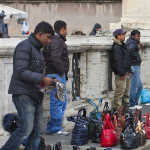
During your visit to Rome, you will notice many illegal sellers, who almost entirely come from South Asia countries (especially Bangladesh and Pakistan). They sell selfie stick, hats, headscarves, toys, flowers, drinks and different things. The illegal market of counterfeit luxury bags, is entrusted to illegal sellers of African origin.
Italian authorities are engaged in a major effort to stamp out the illegal production and sale of counterfeit goods.
Keep in mind that unregulated activities and forgery erode the principles of economy and commercial activity and by buying those products you can be charged with conspiracy to handle stolen goods or uncautious purchase, or with an administrative sanction that can come to a few thousand euros.
If you find yourself in front of their sometimes arrogant harrassment, ignore them and do not buy anything.
There are many shops in Rome where you can buy the same kind of products at the same price.
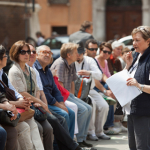
Around tourist attractions you might encounter false tour guides who will offer you a tour for twenty or thirty euros.
If you accept, you risk being fooled by unlikely stories, made up legends and an abstract description of the monuments (which sometimes is also incorrect).
There are also promotors offering tours where you can skip the line, especially for the Colosseum and Vatican museums. Apart from being illegal, they charge three times the value of the tickets.
If you wish to avoid the queue you can use online bookings and if you need a guide you can use the ones available on these websites:
> Rome guide centre
> Vatican guided tours
> Coopculture
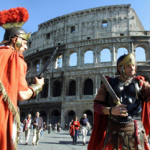
The law forbids these fake gladiators from standing beside the monuments but you can still find some of them in touristic places.
They will ask you for a tip in exchange for each picture you take with them and more often than not this ‘tip’ is usually a high price, so if you really cannot say no, don’t photograph them. There are much better things in this city to photograph!!
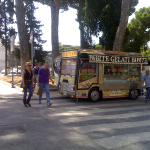
There are different opinions on the quality and the preservation of the food that is sold in these bars and most people seem to prefer traditional structures like restaurants and pizzerias where the conditions allow a more reliable restorative offer.
If you decide to buy something from these bars on wheels, always remember to ask for a receipt, and if in need, you can call the Italian Finance Police by dialling 117 or the Roman Capital Police by calling this number +39 0667691.
If you love street food, you have many alternatives, and you can find some suggestions in the section “Eating”.
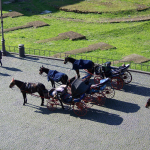
Carriages, known as “botticelle”, are tourist carriages towed by horses.
Their heritage may seem “romantic” but behind it hides the reality that these docile animals have to face, made of tiresome rounds under the sun, sometimes in the hottest hours of the day, forced labour in peak traffic hours, in conditions which are often unbearable.
We strongly recommend you avoid getting on a carriage in very hot days, in order not to damage the health of the horses.
Make sure you bargain with the drivers, they tend to ask for exorbitant fees.
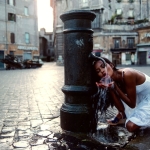
There are about 2,500 fountains with drinkable water in Rome, and 200 of them are in the centre.
If you don’t want to spend a fortune buying water bottles, provide yourself with an empty one or with a canteen and fill it up from the fountains.
You will find plenty in the streets and if you have a smartphone, you can download the app here (for iPhone, iPad and iPod touch) which will tell you where they are located, or you can download the map in pdf format from here.
Moreover, close to the Colosseum, Castel Sant’Angelo, San Pietro railway station and Ottaviano and Cipro underground stations you can find the “Case dell’acqua” (Water Houses), where the public can stock up, free of charge, on both natural and fizzy mineral fresh water (9 °C – 48 °F). You can also charge your phone or tablet via USB ports and read public utilities information on the screen.

You may not be able to enter the Churches or some museums if you are not dressed properly.
In general it is good practice to avoid showing shoulders, your back and tummy or to wear shorts or skirts which are too revealing. You are not allowed to enter St Peter’s Basilica in the Vatican if you are wearing shorts.
It could be a good idea to carry around scarfs or a sarong, in order to cover your shoulders and legs before you enter places of worship, and then put them back easily into a backpack.





